Arduino board, or Arduino shield?
Yes, the "Arduino Ethernet board WITH PoE" is a stand-alone Arduino board, not a shield. You don't need another Arduino board to fully use it.
The "Arduino Ethernet board WITHOUT PoE" is an Arduino board with all the parts of:
- Arduino Ethernet Shield WITHOUT PoE
- Arduino Uno board, minus the USB to serial converter.
all crammed together on one board.
If you solder a PoE module to a Arduino Ethernet Shield WITHOUT PoE Module, you get an "Arduino Ethernet Shield WITH PoE" (a), (b).
If you solder a PoE module to a "Arduino Ethernet board WITHOUT PoE",
you get an "Arduino Ethernet board WITH PoE".
USB to serial converter
Yes, as is explicitly stated on the page you linked,
"any FTDI-style USB-to-serial connector can be used to program it.".
The main documentation page for the Arduino Ethernet board
also mentions that
"The 6-pin serial programming header is compatible with the USB Serial adapter and also with the FTDI USB cables or with Sparkfun and Adafruit FTDI-style basic USB-to-serial breakout boards."
That includes
the "USB 2 Serial Converter" (a) (b), or
the Mini USB Adapter , or
the FTDI Basic Breakout - 5V, or
the FTDI Cable 5V, or
the FTDI Friend, or
etc.
Any of them work identically and can be used to program the Arduino Ethernet board and most other Arduino boards that don't already have an on-board USB to serial converter.
How does the Ethernet with PoE get power?
The Arduino Uno can be powered by either USB power or 7V-12V power sent through the barrel jack or 7V-12V power sent through the GND and VIN pins.
The and "Arduino Ethernet board WITHOUT PoE" can also be powered in any of these ways.
The Arduino Ethernet board WITH PoE can be powered in any of those ways, or in addition it can be powered through the Ethernet jack.
The Wikipedia Power over Ethernet article describes some of the more popular ways to send power through an Ethernet cable.
A PoE injector is a device that pushes power into the Ethernet cable at one end.
A "Alternative A" injector sends power over the same two pairs of wires used to send data.
A "Alternative B" injector sends power over the other "spare" two pairs of wires that are not used to send data.
A PoE splitter is a device that pulls the power out of the Ethernet cable at the other end.
In the terminology of that article, the Arduino Ethernet board WITH PoE is a "Powered device" that combines a (data) Ethernet endpoint and a (power sink) PoE splitter in one device -- you don't need a separate PoE splitter.
You do not need a PoE splitter -- such as "the silver and black box in the middle" of this photo -- in order to separate the power from the data at the Arduino end of the Ethernet cable.
All the functionality of that splitter is already built-in to the "Arduino Ethernet board WITH PoE".
As far as I can tell, the PoE module on all the "Arduino Ethernet board WITH PoE" and all the "Arduino Ethernet Shield WITH PoE" are the
Ag9120-S PoE Module (a), (b), (c).
According to datasheet for the Ag9120-S PoE module,
it is IEEE802.3af compliant, and therefore supports both "Alternative A" and "Alternative B" injectors.
The datasheet also recommends a minimum of 36 V at the jack.
So if you have an Ethernet switch that already has a built-in PoE injector,
you should be able to plug a standard Ethernet cable into the switch and the other end into the "Arduino Ethernet board WITH PoE",
and it should Just Work, with power and data transferred over that single Ethernet cable.
If your Ethernet switch does not already have a built-in PoE injector,
there are a variety of midspan injectors that would work.
(a), (b), (c), (d), (e), etc.
Any standard 802.3af-compliant or 802.3at-compliant injector will work with it.
Also, there are many non-standard "passive PoE" that will usually work with it.
If you are willing to use non-standard PoE,
one very low-cost choice is:
Buy the
The Adafruit Passive PoE Injector Cable Set
(a non-standard "passive PoE" system),
throw away the "splitter" half of the set,
plug the "injector" half of the set into your switch and to a 48 VDC power supply (or at least in the 44.0 V to 57.0 V range),
and then plug the Ethernet cable (which leads to the Arduino)
into the other side of that injector.
(Using a 12 V power supply won't hurt anything, but it's apparently not enough to turn on a standard PoE endpoint).
On the other hand, if you are willing to use non-standard PoE,
you can save even more money by using "Arduino Ethernet WITHOUT PoE"
(instead of the more expensive "Arduino Ethernet board WITH PoE"),
with a "Adafruit Passive PoE Injector Cable Set",
with the "injector" half connected as previously described at the switch end of the Ethernet cable,
and the "splitter" half of of the set connected at the Arduino end,
as shown on its web page.
However, in this case you use something like a 12 VDC a power supply
(or at least in the range of 7V to 20V).
(Alas, using a 48 V power supply with this configuration probably will permanently damage the Arduino boards).
 It's not POE compliant, but it doesn't need to be. It is still does what you need though, allowing you to run a single cable instead of two.
It's not POE compliant, but it doesn't need to be. It is still does what you need though, allowing you to run a single cable instead of two.